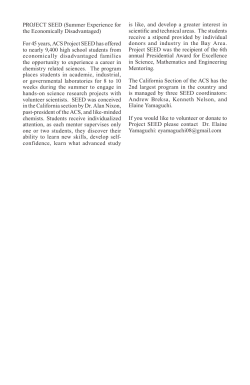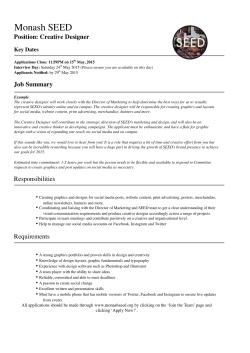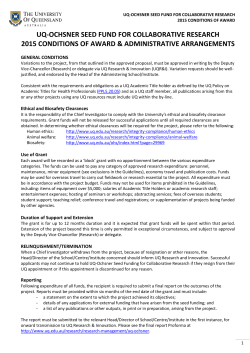
Seed Treatments - Mississippi Soybean Promotion Board
SOYBEAN SEED TREATMENTS AND INOCULANTS considered for broad-spectrum control of both classes of fungi. Fungicide Seed Treatments Many studies have shown that using a seed treatment results in a greater plant population than is achieved without seed treatment. This, then, can be used to decide what seed treatment expense is justified in the absence of an anticipated yield increase. The following example illustrates this point. Seed and seedling diseases will reduce germination and/or emergence of soybeans. Using an appropriate fungicide treatment on soybean planting seeds will increase the probability of achieving a satisfactory stand and will enhance early-season vigor of established seedlings. When seed of preferred varieties is in short supply or seed for replanting may not be available, using a seed treatment fungicide to enhance emergence and stand establishment of a first planting is imperative. Environments in which fungicide seed treatments provide benefit are early planting in cool wet soils with anticipated slow seedling emergence and growth, minimum-till or no-till systems, fields with high amounts of surface residue, fields that are planted continuously to soybeans, and fields with a previous history of seedling diseases. There are two classes or types of seed treatment fungicides. Contact or protectant fungicides are active against pathogens present on planted seeds. Systemic fungicides are active against soil- and residue-borne fungi that attack planted seeds if soil conditions promote disease development. Pythium, Phytophthora, Fusarium, Phomopsis, and Rhizoctonia are the most common pathogens that reduce soybean germination and emergence, and represent both of the above classes. Fungicide combinations that control or suppress these pathogens are shown in the accompanying table and should be WWW.MSSOY.ORG. May 2015 Soybean stands are often increased by over 10% when the proper seed treatment is used. Therefore, a planned seeding rate of 150,000 seeds per acre can be reduced by at least 15,000 seeds per acre and still achieve the desired stand. For a variety that has 3,000 seeds per pound, this translates to saving 5 pounds of seed or $6.00 per acre when seed cost is $1.20 per pound. Thus, using an effective fungicide seed treatment that costs no more than $6.00 per acre (most cost less) can be justified in seed cost savings alone. Saving 15,000 seeds per acre also means that 10 acres instead of 9 can be planted with the same amount of seed. On a broader scale, 1,000 vs. 900 acres can be planted with the same amount of seed of a preferred variety if seeding rate is reduced from 150,000 to 135,000 per acre. This is an important consideration if seed of the preferred variety are unavailable for replanting. Use the information in the below table to determine the most appropriate broadspectrum seed treatment fungicide to use in your environment. Labels for each listed product can be accessed by clicking on the product name. Information about rates and product effectiveness against damage by various pathogens can be accessed by clicking on the sites in the table footnote. 1 Be especially mindful of these additional important points related to the decision of whether or not to use fungicide seed treatments, and your selection of a treatment. ! ! ! It is difficult to place a value on the additional benefit gained from using a broad-spectrum fungicide seed treatment in years and environments that have a history of unforeseen conditions after planting that will reduce stand below the level for optimum yield potential. WWW.MSSOY.ORG. May 2015 ! Using a broad-spectrum seed treatment is cheap insurance to avoid replanting a failed stand, especially since replanting following a failed stand may result in a lower yield because of the resulting later planting date. Using a fungicide seed treatment that is not broad-spectrum is a poor management decision. When having a seed treatment applied by your seed supplier, ensure that the product that is being applied is a broadspectrum one comparable to those listed in the below table. 2 Seed-treatment fungicide combinations (contact + systemic) available for broad-spectrum control of soybean seed and seedling diseases, organisms controlled or suppressed by each fungicide product, and efficacy rating* for control of indicated pathogens. FRAC (Fungicide Resistance Action Committee) code indicates mode of action. Rotation of fungicides with different FRAC codes should minimize selection for fungicide resistance. Pathogens controlled or suppressed and efficacy rating* Trade name Ingredients (FRAC code) ApronMaxx (RTA and RFC) and Warden RTA Mefenoxam (4)+Fludioxonil (12) Pythium (E), Phytophthora (E), Fusarium (G), Phomopsis (G), Rhizoctonia (G) Bean Guard/Allegiance Metalaxyl (4)+Captan (M4)+ Carboxin (7) Pythium (E), Phytophthora (E), Fusarium (G), Rhizoctonia (G) Prevail Metalaxyl (4)+Carboxin (7)+ PCNB (F3) Pythium (E), Phythophthora (E), Fusarium (U), Phomopsis (G), Rhizoctonia (G) Trilex 2000 Trifloxystrobin (11)+Metalaxyl (4) Pythium (E), Phytophthora (F), Fusarium (G), Phomopsis (G), Rhizoctonia (G) Acceleron: DX-109, DX-309, DX-612 Pyraclostrobin (11)+Metalaxyl (4)+ Pythium (E), Phytophthora (E), Fluxapyroxad (7) Fusarium (G), Phomopsis (G), Rhizoctonia (E), ILeVO Fluopyram (7) Fusarium virguliforme (VG), SDS pathogen *Efficacy ratings: E = Excellent; G, VG = Good, Very Good; F = Fair; P = Poor; U = Unknown or Not Recommended. Only ILeVO has efficacy against Fusarium virguliforme, the causal agent of SDS (sudden death syndrome). Cautions: Check product label for compatibility with B. japonicum inoculant, and do not feed or sell treated seeds that are not planted. Resources: University of Arkansas; Management of Soybean Seedling Diseases—Fungicide Efficacy for Control of Soybean Seedling Diseases—May 2015—Univ. of Delaware; and Fungicide efficacy for control of soybean seedling diseases—June 2014—Purdue Extension. WWW.MSSOY.ORG. May 2015 3 Insecticide Seed Treatments An additional management option for Mississippi soybean farmers is the treatment of planting seed with an insecticide in addition to the already proven effective treatment with fungicides. Available products contain systemic insecticides that provide effective control of early generations of bean leaf beetle, thrips, and three-cornered alfalfa, among others. They generally have a short period of efficacy (30 to 45 days), and are not a replacement for late-season insect control that may be necessary in some fields. Results from numerous studies indicate that using these insecticidal seed treatments results in small but significant yield increases that apparently result from lessening the damage caused by insect pests early in the season. All-in-one products that contain both fungicides and an insecticide are available. Products are: Trilex 6000, which contains the fungicides found in Trilex 2000 and the insecticide found in Gaucho; CruiserMaxx, which contains the fungicides found in Apron Maxx and the insecticide found in Cruiser 5FS; CruiserMaxx Plus contains a nearly 2X rate of mefenoxam fungicide for increased protection against Pythium and Phytophthora fungal pathogens, which are problematic in Delta clay soils; and Acceleron seed treatment with insecticide, which is a combination of DX-109, DX-309, DX-612 fungicides with IX-409 insectide (imidacloprid). The benefits from using a fungicide seed WWW.MSSOY.ORG. May 2015 treatment are well known. All indications are that those benefits are increased by using one of the seed treatment products that combines fungicides and an insecticide. Resistance management is always paramount when using pesticides; therefore, these insecticidal products should be used only if you the producer are confident that you have had or will have potential crop damage from earlyseason insects. This has certainly been the case with three-corned alfalfa hopper in many Mississippi fields over the years, and there is evidence that increasing pressure from thrips is worth taking note of. Nematicide Seed Treatments All soybean production regions of the US experience problems with soybean cyst nematode (SCN), and SCN is especially problematic on the silt loam and coarsertextured soils of the Midsouth. With the increasing transfer of Midsouth cotton acreage to soybeans, reniform nematode infection of soybeans has become a concern as well. Root knot nematodes can also be problematic in the Midsouth since soybeans, cotton, and corn all serve as hosts. Nematicides applied to seed or used in-furrow can reduce early-season root infection by nematodes, but do not provide season-long control and may not be economical. Nematicides can be effective in controlling SCN populations in infested fields, but their use should be based on expected yield and subsequent income, given that lessened yield loss resulting from their use in low-yield environments may not result in yields that are sufficient to be profitable. 4 Nematicides will not replace the use of resistant varieties and variety/crop rotation as primary nematode control practices. Click here for up-to-date nematode resistance ratings for Midsouth soybean varieties. Nematode control products that can be applied in combination with fungicide/insecticide seed treatments are available. ! ! ! Votivo is a biological seed treatment that provides early-season protection against the above three nematode species. Poncho/Votivo is a combination insecticide/nematicide that is applied to the seed prior to planting. Avicta Complete Beans is a seed treatment product that combines a nematicide (Avicta 500FS) with a fungicide (Apron Maxx) and/or insecticide (Cruiser 5FS), or CruiserMaxx premix. As with the above product, little is known about the effectiveness of this nematicide in situations with known populations of nematodes. Clariva Complete Beans nematicide/insecticide/fungicide seed treatment is an on-seed application of separately registered products that has the added nematicide component for control of soybean cyst nematode (SCN). The nematicide component is in addition to the insecticide/fungicide components found in CruiserMaxx Beans with Vibrance. The nematicide component only targets SCN and not other nematode species. The following links provide detail about this product from Syngenta, the company that developed and is marketing Clariva. Syngenta Description WWW.MSSOY.ORG. May 2015 Syngenta Technical Overview Syngenta video Syngenta Power Point Presentation Available information indicates the cost of the nematicide component will increase the seed treatment cost about $8 to $10 per acre above that for the product without the nematicide. A Plant Management Network webcast titled “Evaluation of Seed-Applied Nematicide on Soybeans” presents the first year (2014) of results from evaluating the effect of Clariva on SCN across the state of Iowa. These first-year results indicate that Clariva does negatively affect SCN’s ability to reproduce, but the long-term effect of this reduction on soybean performance can only be determined with additional years of research. At this time, little is known about the effectiveness of the above nematicides in situations with known populations of nematodes. Thus, there is no supposition that any of these products will replace the accepted practices for nematode control and/or management. In fact, they should be used in combination with the accepted practices specified in the above-linked article. See the article on this website for more information about using seed treatments for soybean planting seed. Inoculants The benefit from using rhizobium-containing inoculants is not as clearcut as are the benefits from using fungicide and insecticide seed treatments. We all know that these bacteria must be present in the soil in sufficient 5 numbers for proper nodulation on soybean roots to occur. What we don’t know in such a hard-and-fast fashion is just when to expect an economic or agronomic response when inoculants are applied. Points to consider in the decision of whether or not to use an inoculant are: ! ! ! ! ! An appropriate inoculant is cheap, generally less than $3/acre. Thus, cost is not a factor in deciding whether or not to inoculate. Do not apply inoculants to gain a yield increase. Rather, apply them to ensure that nitrogen fixation will be sufficient for the crop to realize the yield potential from the planted site. Inoculants are generally not compatible with fungicide seed treatments, so inoculant application must be made at planting. This will slow the planting operation. There is overwhelming evidence that applying inoculants to soils that have recently been cropped to soybeans provides no yield benefit. The cheapness of inoculants warrants their application when soybeans have not been grown recently on a site and the risk of WWW.MSSOY.ORG. May 2015 ! ! ! ! insufficient native soil inoculum is high. The importance of this fact is because there is no option after planting but to apply expensive nitrogen fertilizer to overcome the effects of poor nodulation. With the change in cropping systems that is occurring in Mississippi, it is a good idea to inoculate when soybeans are planted on a site that has had continuous cotton or corn or if the site has not been cropped to soybeans in the last 4 to 5 years. There is a potential advantage from choosing inoculant products that contain more than one strain of bacteria. Results from a study that was planted behind the 2011 flood in Mississippi showed no advantage for applying inoculants even though the flood period was several weeks. Links to articles by soybean specialists in Arkansas, Iowa, and Mississippi provide concise summaries that can be quickly perused to help in your decision about using inoculants. Composed by Larry G. Heatherly, Revised/Updated May. 2015. Contact: larryheatherly@bellsouth.net 6
© Copyright 2025










